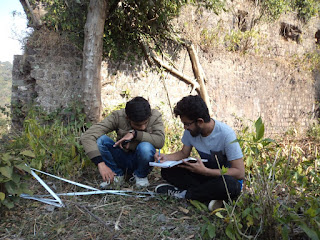SA Member-run-Workshops: Project Ruins by Mayank Singh
 I am not sure where, on the priority list of the Indian régime, does heritage conservation lie, but it certainly does lie well below changing names and raising statues.
I am not sure where, on the priority list of the Indian régime, does heritage conservation lie, but it certainly does lie well below changing names and raising statues.
Sitting atop a hillock, overlooking the lush green fields, lie the ruins of Rehlu fortress. Once an important outpost on the borders of the hill states of Kangra and Chamba, the once-imposing building and the small village below, hold stories of a vibrant past, but today, everything seems to have been forgotten beneath the sheets of the soil and spoils of the fort walls.
The place had always been an object of fascination for me since I was a teenager, and was shrouded enough in wilderness to excite a bunch of adrenaline pumped teenagers, such as I was. Despite the fascination of many like me, though, it was never significant historically and probably will never be, but it was this place, in particular, that made me fall in love with ruins. Hence, this was the perfect setting for my first Member-run-Workshop at Speaking Archaeologically.
So, on a fateful January morning, along with a couple of my friends, I set out in the warm winter sun, armed with measuring tapes and marking threads, to plan the fortress. This was the same road I had been on many times before but this time with I was here with a purpose - to plan the complex and if possible, to find ways for conserving the place.
As we climbed our way up to the main entrance, all we could see was bushes, shrubs and moss covering the complex. Though it was not enough to deter us from going ahead, it literally was a thorny task. We started off with the perimeter and gradually, moved on to the take the measurements of the other structures inside. Then we sat in the open, where, probably, the garrisoned soldiers would have once sat and talked. The first thing we did was draw a rough plan. I went on to explain the importance of planning a floor map, to find parallels of a structure and its implications on research.
The fortress was a simple rectangular complex, housing a main residential building in the centre and four octagonal watchtowers in the four corners(of which only one survives today). Also, there is a well and two structures that were probably being used as storage tanks.
We were soon joined in by bunch of villagers, who were quite intrigued to see us with the measuring
tapes. When asked about the dilapidated state of affairs, they told us that the place was once home to the Mirzas, but took serious damage in the 1905 earthquake and since then, was abandoned. As years passed by, the stones were taken away by the villagers to be used as construction material. Further investigation of the construction of the building led us to a timeline of around late 18th century, when it was built or strengthened by Raj Singh of Chamba. Although some people also mention the place to have accommodated Birbal, the then Jagirdar of Kangra under Akbar, but no records of the same could be found. The construction, an old man from the village recalled, used to be transported by the villagers from the rivulet below.
tapes. When asked about the dilapidated state of affairs, they told us that the place was once home to the Mirzas, but took serious damage in the 1905 earthquake and since then, was abandoned. As years passed by, the stones were taken away by the villagers to be used as construction material. Further investigation of the construction of the building led us to a timeline of around late 18th century, when it was built or strengthened by Raj Singh of Chamba. Although some people also mention the place to have accommodated Birbal, the then Jagirdar of Kangra under Akbar, but no records of the same could be found. The construction, an old man from the village recalled, used to be transported by the villagers from the rivulet below.
The place was under Raja Azimullah Khan, the title having been conferred to him by the British, until the Partition of India in 1947, after which the descendants fled to Pakistan. The villagers, however, said that the family visited the village time and again, even after this.
The ruined structure is an old book, a collection of stories. They say walls have ears, but we often do not realise they have a mouth, too, waiting for someone to lend their ear, waiting for someone to hear their stories. This fortress is not an isolated case of negligence on part of the concerned authorities, but many such buildings-an assemblage of history-lie neglected in the Western Himalayas and it’s high time we start listening to their forgotten voices, before they all die out forever.





Great work!
ReplyDeleteKeep amazing us with your awesome work.
ReplyDeleteWaaao .....I am pleased after reading this....will definitely go to this place 💕
ReplyDeleteAwesome information & explanation
ReplyDelete